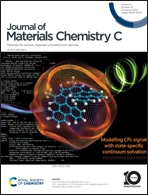Thermally activated delayed fluorescence from confined carbon dots activated by the triple synergy effect for advanced information encryption†
Abstract
Thermally activated delayed fluorescence (TADF) materials have attracted much attention in information encryption because of their long lifetime, high quantum yield, and excellent optical properties. Nonetheless, triplet-state excitons are quenched in the presence of oxygen and deactivated by nonradiative transitions caused by the vibration and rotation of molecules, making it difficult to obtain materials with TADF properties. Here, three components are selected, including carbon dots (CDs), montmorillonite (MMT), and polyvinyl alcohol (PVA). Due to the synergy of multiple interacting forces, the excellent TADF properties of CD-MMT@PVA films are activated. The confined space and electrostatic attraction of MMT can restrain the CD's motion and avoid aggregation-caused quenching (ACQ), which lays the foundation for obtaining TADF. The strong repulsive interaction and hydrogen bonding between PVA and CD–MMT promote the formation of rigid structures, which will be less non-radiative decay of triplet state excitons and successfully activate the TADF of CD-MMT@PVA films. Based on the above synergies, the CD-MMT@PVA composite has a TADF lifetime of 30.23 ms and a fluorescence quantum yield of 45.66%, which provides a new design idea for highly efficient organic–inorganic TADF composites.



 Please wait while we load your content...
Please wait while we load your content...